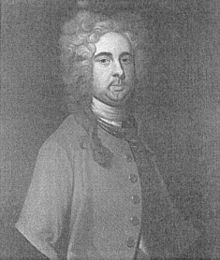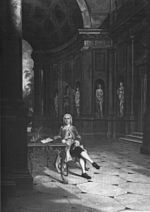- Charles Calvert (governor)
-
For other people named Charles Calvert, see Charles Calvert (disambiguation).
Captain Charles Calvert 
Captain Charles Calvert, Governor of Maryland. Painting by John Wollaston. Collection of the Baltimore Museum of Art. Governor of Maryland In office
1720–1727Preceded by Thomas Brooke Succeeded by Benedict Leonard Calvert Surveyor General to the Western Shore In office
1726 – c1733Commissary General[1] In office
1727–1728Personal details Born 1688
EnglandDied 1734
MarylandSpouse(s) Rebecca Gerard Relations Charles Calvert, 3rd Baron Baltimore (father)
Charles Calvert, 5th Baron Baltimore (cousin)Occupation planter, politician Captain Charles Calvert (1688 – February 2, 1734) was the 14th Proprietary Governor of Maryland in 1720, at a time when the Calvert family had recently regained control of their proprietary colony. He was appointed Governor by his cousin Charles Calvert, 5th Baron Baltimore, who in 1721 came into his inheritance. Calvert worked to reassert the Proprietary interest against the privileges of the colonists as set out in the Maryland Charter, and to ease tensions between the Lords Baltimore and their subjects. Religious tension, which had been a source of great division in the colony, was much reduced under his governorship. Captain Calvert was replaced as governor in 1727 by his cousin Benedict Leonard Calvert, though he continued to occupy other colonial offices.[2] He suffered from early senility and died in 1734.
Contents
Early life
Calvert was born Charles Calvert Lazenby in England in 1688.[3] Neither of his parents has been positively identified but it has long been assumed that his father was Charles Calvert, 3rd Baron Baltimore, 2nd Proprietor Governor of Maryland (1637–1715). His mother's identity in unknown but, judging by the Calvert family papers, she appears to have been the Countess Henrietta, also known as "Mother Calvert", who died circa 1728.[4]
Military career
Calvert served in England's wars against France and Spain, most likely reaching the rank of ensign by around 1709.[1] In 1718 Calvert purchased further commissions in the army, becoming at aged 30 first a lieutenant and later a captain in the Grenadier Guards, promotions which most likely were financed by his wealthy Calvert patrons.[5] Guards Regiments were among the most prestigious in the army and commissions were comparatively expensive.[5]
Governor of Maryland
Calvert was appointed Governor of Maryland in around 1720, sent to advance the interests of his Calvert relatives, who had recently regained control of the colony of Maryland which had been confiscated by the Crown following the events of the Glorious Revolution in 1688. Among the reasons for his appointment were his loyalty to the Crown, his desire to live permanently in Maryland, and above all else his presumed loyalty to the family interest.[5] Calvert was a pragmatic man not given to ostentation. His opening speech to the Assembly was brief, inviting the delegates "to let time and my actions show" that his governorship would serve the interests of the colony.[6]
According to Aubrey Land, his mission was initially "soothing tempers and making peace".[5] He laboured to strike an acceptable balance between the interests of the Maryland colonists and those of the Lord Proprietor, and in addition to manage relations with the local Algonquian tribes. To this end Calvert entered into negotiations with the tribal chiefs of the Seneca, Tuscarora and Shawnee Indians.[5]
Calvert replaced as Governor the Protestant Thomas Brooke, whose "malicious designs" he had been sent to bring to an end. Early on he worked to reassert the Proprietary interest and prerogative against the privileges of the colonists as set out in the Maryland Charter.[5] He also worked to ease tensions between the propriety government and its subjects. In a speech in 1725 he suggested that their differences might be of a devilish nature:
- "I am afraid some Evil Spirits walk among us and it would be a matter of Great pleasure to such, to have your house [the people of Maryland] and mine [Lord Baltimore] att Variance, but for my own part, I defy the Devill and his Works to do it".[3]
Marriage
As governor of the Province, Calvert was a most eligible bachelor. He took as his wife Rebecca Gerard (1708-1734/35) a landed heiress from Maryland,[7] who was just sixteen when the couple were married on November 21, 1722 by the rector of Queen Anne's parish,[7] a marriage which "enlivened the whole winter season with entertainments for the new first lady", wrote Aubrey Land.[7] She was an only child and on her marriage her property, a plantation near Queen Anne's Town in Prince George's County, passed to Captain Calvert.[8]
Calvert was an excellent horseman and promoted horse racing during his tenure as Governor. When he died he left behind a thoroughbred worth 18 pounds sterling, a considerable sum at the time.[7]
Religion
The religious disputes which had characterized Maryland politics in earlier years were subdued under Calvert's rule. Rules forbidding the practice of Roman Catholicism were relaxed and, in general, religious conflict was much reduced.[9]
Replacement as governor
Captain Calvert was replaced as Governor when his cousin Benedict Leonard Calvert, brother of Charles Calvert, 5th Baron Baltimore, arrived in Maryland in 1727.[10] The handover of power to his cousin was not entirely smooth. Captain Calvert insisted on retaining fifty percent of the 3 pence tobacco duty which was his due under legislation passed in 1727. Benedict was not impressed, and his younger brother Cecilius wrote to him that family opinion in England was appalled at Captain Calvert's behaviour, and "thinks him mad".[10] Lord Baltimore himself wrote that Benedict should receive the full benefit of the tax.[10]
From 1726 to c. 1733 Calvert served as Surveyor General to the Western Shore.[11]
Family life
The Calverts had three children:
- Charles (1723-1723/4), died in infancy.[12]
- Anne (1724-c1737), died in childhood.[12]
- Elizabeth Calvert (1731-1788), who married her cousin Benedict Swingate Calvert (c. 1730-1788), on April 21, 1748, in St Ann's Church, Annapolis. The couple were married by the Reverend John Gordon.[13] Benedict Swingate Calvert was the illegitimate son of Charles Calvert, 5th Baron Baltimore, the third Proprietor Governor of Maryland, and a wealthy planter. They had thirteen children. Elizabeth's godfather was Captain Calvert's cousin, Benedict Leonard Calvert, second son of Benedict Calvert, 4th Baron Baltimore, who died of consumption in 1732.[14]
Illness and death
Captain Calvert suffered from early senility and died on February 2, 1734, aged 42.[15] He had arrived in Maryland a relatively poor man, but died one of the wealthiest men in the Province.[10] On his death his estate was appraised at 4,401 pounds sterling.[10] His wife died Rebecca soon afterwards, and in 1737 their daughter Anne died, leaving their last remaining child Elizabeth an orphan, but a wealthy heiress.[15]
Legacy
Captain Calvert's house at 58 State Circle, Annapolis, was the subject of an archeological dig in the l980s and early 1990s. The results of the dig, along with much other research, were published in 1994 by Anne Elizabeth Yentsch in her book A Chesapeake Family and their Slaves, published by Cambridge University Press. The excavation of the Calvert House was financed by Historic Annapolis Inc, the National Endowment for the Humanities, and other institutions. [16]
Notes
- ^ a b Peden, Henry C, p.55, Colonial Maryland Soldiers and Sailors, 1634-1734 Retrieved August 3 2010
- ^ Yentsch, Anne E, p.40, A Chesapeake Family and their Slaves: a Study in Historical Archaeology, Cambridge University Press (1994) Retrieved August 3 2010
- ^ a b Yentsch, Anne E, p.53, A Chesapeake Family and their Slaves: a Study in Historical Archaeology, Cambridge University Press (1994) Retrieved August 9 2010
- ^ Yentsch, Anne E, p.55, A Chesapeake Family and their Slaves: a Study in Historical Archaeology, Cambridge University Press (1994) Retrieved Jan 2010
- ^ a b c d e f Yentsch, Anne E, p.56, A Chesapeake Family and their Slaves: a Study in Historical Archaeology, Cambridge University Press (1994) Retrieved Jan 2010
- ^ Yentsch, Anne E, p.57, A Chesapeake Family and their Slaves: a Study in Historical Archaeology, Cambridge University Press (1994) Retrieved Jan 2010
- ^ a b c d Yentsch, Anne E, p.64, A Chesapeake Family and their Slaves: a Study in Historical Archaeology, Cambridge University Press (1994) Retrieved Jan 2010
- ^ Yentsch, Anne E, p.65, A Chesapeake Family and their Slaves: a Study in Historical Archaeology, Cambridge University Press (1994) Retrieved Jan 2010
- ^ Andrews, p.226
- ^ a b c d e Yentsch, Anne E, p.61, A Chesapeake Family and their Slaves: a Study in Historical Archaeology, Cambridge University Press (1994) Retrieved Jan 2010
- ^ Yentsch, p.13
- ^ a b Yentsch, p.66
- ^ Russell, George, p.8, The Ark and the Dove Adventurers Retrieved Jan 28 2010
- ^ Yentsch, Anne E, p.93, A Chesapeake Family and their Slaves: a Study in Historical Archaeology, Cambridge University Press (1994) Retrieved Jan 2010
- ^ a b Yentsch, Anne E, p.69, A Chesapeake Family and their Slaves: a Study in Historical Archaeology, Cambridge University Press (1994) Retrieved Jan 2010
- ^ Yentsch, Anne E, Preface, p.xxiii
References
- Andrews, Matthew Page, History of Maryland, Doubleday, New York (1929).
- Peden, Henry C, p.55, Colonial Maryland Soldiers and Sailors, 1634-1734 Retrieved August 3 2010
- Yentsch, Anne E, A Chesapeake Family and their Slaves: a Study in Historical Archaeology, Cambridge University Press (1994) Retrieved Jan 30 2010
External links
- Calvert Family Tree Retrieved Jan 24 2010
- Charles Calvert described in Maryland Archives at www.msa.md.gov Retrieved October 2010
See also
Categories:- Colonial Governors of Maryland
- Calvert family
- 1688 births
- 1734 deaths
Wikimedia Foundation. 2010.



